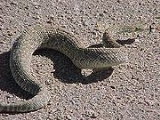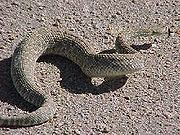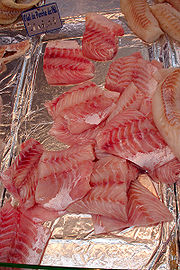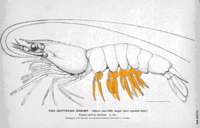
Undulatory locomotion
Encyclopedia

Lamprey
Lampreys are a family of jawless fish, whose adults are characterized by a toothed, funnel-like sucking mouth. Translated from an admixture of Latin and Greek, lamprey means stone lickers...
. Although this is typically the type of gait utilized by limbless animals, some creatures with limbs, such as the salamander, choose to forgo use of their legs in certain environments and exhibit undulatory locomotion. This movement strategy is important to study in order to create novel robotic devices capable of traversing a variety of environments.
Environmental Interactions
In limbless locomotion, forward locomotion is generated by propagating flexural waves along the length of the animal's body. Forces generated between the animal and surrounding environment lead to a generation of alternating sideways forces that act to move the animal forward. These forces generate thrust and drag. (add picture)Hydrodynamics
Simulation predicts that thrust and drag are dominated by viscous forces at low Reynolds numbers and inertial forces at higher Reynolds numbers. When swimming in a fluid two main forces are thought to play a role:- Skin Friction: Generated due to the resistance of a fluid to shearing and is proportional to speed of the flow. This dominates undulatory swimming in spermatozoa and the nematode
- Form Force: Generated by the differences in pressure on the surface of the body and it varies with the square of flow speed.
At low Reynolds number (Re~100), skin friction accounts for nearly all of the thrust and drag. For those animals which undulate at intermediate Reynolds number (Re~101), such as the Ascidian larvae, both skin friction and form force account for the production of drag and thrust. At high Reynolds number (Re~102), both skin friction and form force act to generate drag, but only form force produces thrust.
Kinematics
In animals that move without use of limbs, the most common feature of the locomotion is a rostral to caudal wave that travels down their body. However, this pattern can change based on the particular undulating animal, the environment, and the metric in which the animal is optimizing (i.e. speed, energy, etc.). The most common mode of motion is simple undulations in which lateral bending is propagated from head to tail.- Snake Locomotion
See also Snakes
Snakes can exhibit 5 different modes of terrestrial locomotion: (1) lateral undulation, (2) sidewinding
Sidewinding
Sidewinding is a type of locomotion unique to caenophidian snakes, used to move across loose or slippery substrates. It is most often used by the Saharan horned viper, Cerastes cerastes, and the sidewinder rattlesnake, Crotalus cerastes, to move across loose desert sands, but it is also used by...
, (3)concertina
Concertina movement
Concertina movement is the movement occurring in snakes and other legless organisms that consists of gripping or anchoring with portions of the body while pulling/pushing other sections in the direction of movement. Each point on the snake's body goes through alternating cycles of static contact...
, (4)rectilinear
Rectilinear locomotion
Rectilinear locomotion is a mode of locomotion most often associated with snakes, particularly heavy-bodied species like terrestrial pythons and boas, although most snakes are capable of it...
, and (5) slide-pushing. Lateral undulation closely resembles the simple undulatory motion observed in many other animals such as in lizards, eels and fish, in which waves of lateral bending propagate down the snakes body.
- Eel Locomotion
While the American Eel
American eel
The American eel, Anguilla rostrata, is a catadromous fish found on the eastern coast of North America. It has a snake-like body with a small sharp pointed head. It is brown on top and a tan-yellow color on the bottom. It has sharp pointed teeth but no pelvic fins...
typically moves in an aquatic environment it can also move on land for short periods of time. It is able to successfully move about in both environments by producing traveling waves of lateral undulations. However, differences and terrestrial and aquatic locomotor strategy suggest that the axial musculature is being activated differently, (see muscle activation patterns below). In terrestrial locomotion, all points along the body move in the on approximately the same path and, therefore, the lateral displacements along the length of the eel's body is approximately the same. However, in aquatic locomotion, different points along the body follow different paths with increasing lateral amplitude more posteriorly. In general, the amplitude of the lateral undulation and angle of intervertebral flexion is much greater during terrestrial locomotion than that of aquatic.(insert picture?)
Musculoskeletal System

Muscle Architecture
A typical characteristic of many animals that utilize undulatory locomotion is that they have segmented muscles, or blocks of myomereMyomere
Myomere are the blocks of skeletal muscle tissue found commonly in chordates. They are commonly zig-zag, "W" or "V"-shaped muscle fibers. The myomeres are separated from adjacent myomere by connective tissues and most easily seen in larval fishes or in the olm...
s, running from their head to tails which are separated by connective tissue called myosepta. In addition, some segmented muscle groups, such as the of the lateral hypaxial musculature in the salamander are oriented at an angle to the longitudinal direction. For these obliquely oriented fiber the strain in the longitudinal direction is greater than the strain in the muscle fiber direction leading to an architectural gear ratio greater than 1. A higher initial angle of orientation and more dorsoventral bulging produces a faster muscle contraction but results in a lower amount of force production. It is hypothesized that animals employ a variable gearing mechanism that allows self-regulation of force and velocity to meet the mechanical demands of the contraction. When a pennate muscle
Pennate muscle
A pennate or pinnate muscle is a muscle with fascicles that attach obliquely to its tendon...
is subjected to a low force, resistance to width changes in the muscle cause it to rotate which consequently produce a higher architectural gear ratio (AGR) (high velocity). However, when subject to a high force, the perpendicular fiber force component overcomes the resistance to width changes and the muscle compresses producing a lower AGR (capable of maintaining a higher force output).
Muscle Activity
In addition to a rostral to caudal kinematic wave that travels down the animals body during undulatory locomotion, there is also a corresponding wave of muscle activation that travels in the rostro-caudal direction. However, while this pattern is characteristic of undulatory locomotion, it too can vary with environment.American Eel
Aquatic Locomotion: ElectromyogramElectromyography
Electromyography is a technique for evaluating and recording the electrical activity produced by skeletal muscles. EMG is performed using an instrument called an electromyograph, to produce a record called an electromyogram. An electromyograph detects the electrical potential generated by muscle...
(EMG) recordings reveal a similar pattern of muscle activation during aquatic movement as that of fish. At slow speeds only the most posterior end of the eels muscles are activated with more anterior muscle recruited at higher speeds
Terrestrial Locomotion: EMG recording show a longer absolute duration and duty cycle of muscle activity during locomotion of land. Also, the absolute intensity is much higher while on land which is expect from the increase in gravitational forces acting on the animal. However, the intensity level decreases more posteriorly along the length of the eel's body. Also, the timing of muscle activation shifts to later in the strain cycle of muscle shortening.
Energetics
Animals with elongated bodies and reduced or no legs have evolved differently from their limbed relatives. In the past, some have speculated that this evolution was due to a lower energetic cost associated with limbless locomotion. The biomechanical arguments used to support this rational include that (1) there is no cost associatied with the vertical displacement of the center of mass typically found with limbed animals, (2) there is no cost associated with accelerating or decelerating limbs, and (3) there is a lower cost for supporting the body. This hypothesis has been studied further by examining the oxygen consumption rates in the snake during different modes of locomotion: lateral undulation, concertina and sidewinding. The net cost of transport (NCT), which indicates the amount of energy required to move a unit of mass a given distance, for a snake moving with a lateral undulatory gait is identical to that of a limbed lizard with the same mass. However, a snake utilizing concertina locomotion produces a much higher net cost of transport, while sidewinding actually produces a lower net cost of transport. Therefore, the different modes of locomotion are of primary importance when determining energetic cost. The reason that lateral undulation has the same energetic efficiency as limbed animals and not less, as hypothesized earlier, might be due to the additional biomechanical cost associated with this type of movement due to the force needed to bend the body laterally, push its sides against a vertical surface, and overcome sliding friction.Intersegmental Coordination
Wavelike motor pattern typically arise from a series of coupled segmental oscillator. Each segmental oscillator is capable of producing a rhythmic motor output in the absence of sensory feedback. One such example is the half center oscillatorCentral pattern generator
Central pattern generators are neural networks that produce rhythmic patterned outputs without sensory feedback. CPGs have been shown to produce rhythmic outputs resembling normal "rhythmic motor pattern production" even in isolation from motor and sensory feedback from limbs and other muscle...
which consist of two neurons that are mutually inhibitory and produce activity 180 degrees out of phase. The phase relationships between these oscillators are established by the emergent properties of the oscillators and the coupling between them. Forward swimming can by accomplished by a series of coupled oscillators in which the anterior oscillators have a shorter endogenous frequency than the posterior oscillators. In this case, all oscillators will be driven at the same period but the anterior oscillators will lead in phase. In addition, the phase relations can be established by asymmetries in the couplings between oscillators or by sensory feedback mechanisms.
- Leech
The leech
Leech
Leeches are segmented worms that belong to the phylum Annelida and comprise the subclass Hirudinea. Like other oligochaetes such as earthworms, leeches share a clitellum and are hermaphrodites. Nevertheless, they differ from other oligochaetes in significant ways...
moves by producing dorsoventral undulations. The phase lags between body segments is about 20 degrees and independent of cycle period. Thus, both hemisegments of the oscillator fire synchronously to produce a contraction. Only the ganglia rostral to the midpoint are capable of producing oscillation individually. There is U-shaped gradient in endogenous segment oscillation as well with the highest oscillations frequencies occurring near the middle of the animal. Although the couplings between neurons spans six segments in both the anterior and posterior direction, there are asymmetries between the various interconnections because the oscillators are active at three different phases. Those that are active in the 0 degree phase project only in the descending direction while those projecting in the ascending direction are active at 120 degrees or 240 degrees. In addition, sensory feedback from the environment may contribute to resultant phase lag.

- Lamprey
The lamprey
Lamprey
Lampreys are a family of jawless fish, whose adults are characterized by a toothed, funnel-like sucking mouth. Translated from an admixture of Latin and Greek, lamprey means stone lickers...
moves using lateral undulation and consequently left and right motor hemisegments are active 180 degrees out of phase. Also, it has been found that the endogenous frequency of the more anterior oscillators is higher than that of the more posterior ganglia. In addition, inhibitory interneurons in the lamprey project 14-20 segments caudally but have short rostral projections. Sensory feedback may be important for appropriately responding to perturbations, but seems to be less important for maintaince of appropriate phase relations.
Robotics
Based on biologically hypothesized connections of the central pattern generatorCentral pattern generator
Central pattern generators are neural networks that produce rhythmic patterned outputs without sensory feedback. CPGs have been shown to produce rhythmic outputs resembling normal "rhythmic motor pattern production" even in isolation from motor and sensory feedback from limbs and other muscle...
in the salamander, a robotic system has been created which exhibits the same characteristics of the actual animal. Electrophysiology studies have shown that stimulation of the mesencephalic locomotor region(MLR) located in the brain of the salamander produce different gaits, swimming or walking, depending on intensity level. Similarly, the CPG model in the robot can exhibit walking at low levels of tonic drive and swimming at high levels of tonic drive. The model is based on the four assumptions that:
- Tonic stimulation of the body CPG produces spontaneous traveling waves. When the limb CPG is activated it overrides the body CPG.
- The strength of the coupling from the limb to the body CPG is stronger than that from body to limb.
- Limb oscillators saturate and stop oscillating at higher tonic drives.
- Limb oscillators have lower intrinsic frequencies than body CPGs at the same tonic drive.
This model encompasses the basic features of salamander locomotion.
External links
- Biologically Inspired Robotics Group @ EPFL
- Center for Biologically Inspired Design at Georgia Tech
- Functional Morphology and Biomechanics Laboratory, Brown University
- Peristalsis Robot
- Snake Locomotion
- Research for this Wikipedia entry was conducted as a part of a Locomotion Neuromechanics course (APPH 6232) offered in the School of Applied Physiology at Georgia Tech

